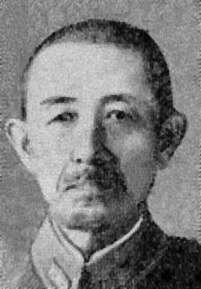Shōzō Sakurai
| Lieutenant General Shōzō Sakurai | |
|---|---|
 Lieutenant General Sakurai Shōzō | |
| Born |
June 27, 1889 Hagi, Yamaguchi, Japan |
| Died |
July 7, 1985 (aged 96) Tokyo, Japan |
| Allegiance |
|
| Service/branch |
|
| Years of service | 1911-1945 |
| Rank | Lieutenant General |
| Commands held | IJA 33rd Division, IJA 28th Army |
| Battles/wars |
Second Sino-Japanese War World War II |
Shōzō Sakurai (樱井 省三 Sakurai Shōzō, June 27, 1889 – July 7, 1985) was a general in the Imperial Japanese Army during the Second Sino-Japanese War and World War II.
Biography
Sakurai was born in Nagoya, although his official records list Hagi city, Yamaguchi prefecture as his hometown.[1] He graduated from the 23rd class of the Imperial Japanese Army Academy in 1911 and the 31st class of the Army Staff College in 1919. He was initially an infantry officer, but became a specialist in military transport. He spent a short time in France as a military attaché. In the early 1930s he was an instructor at the War College, then from 1934 to 1936 commanded the IJA 77th Regiment.[2]
Sakurai then served as an investigator for the Cabinet Planning Department and was in charge of harbor facilities and then attached to Naval Transport Headquarters. In 1938 he became Inspector of Central China Harbor Facilities. He was promoted to major general in March 1938.
In 1938, Sakurai was given command of the Infantry group of IJA 22nd Division and in 1939 was attached to Central China Expeditionary Army headquarters before becoming Chief of Staff of the Thirteenth Army in China. He was promoted to lieutenant general in 1940.
In 1941 Sakurai became commander of IJA 33rd Division in China under IJA 11th Army, and participated in the invasion of Siam and of Burma in the Burma Campaign, and was garrisoned in Arakan.[3] In 1943, Sakurai was reassigned back to Japan as head of the Armored Warfare Department under the Army Ministry. However, in 1944, Sakurai returned to Burma as Commander of Twenty-Eighth Army. His army invaded Bengal (Operation Ha-Go) to draw the British away from Imphal in support of Japanese armies in the U-Go Offensive. By February 22, 1944, the IJA 28th Army had been repulsed with heavy losses and was in retreat. By July 20, 1945, Sakurai had withdrawn to Moulmein, which he held until the end of the war.[3] He died in Tokyo at the age of 96, and his grave is at the Tama Cemetery in Fuchū, Tokyo.
References
Books
- Dupuy, Trevor N. (1992). Encyclopedia of Military Biography. I B Tauris & Co Ltd. ISBN 1-85043-569-3.
- Fuller, Richard (1992). Shokan: Hirohito's Samurai. London: Arms and Armor. ISBN 1-85409-151-4.
- Louis, Allen (1984). Burma: The Longest War. Dent Publishing. ISBN 0-460-02474-4.
External links
- Ammenthorp, Steen. "Lieutenant-General Shozo Sakurai". The Generals of World War II.
- Budge, Kent. "Shozo Sakurai". Pacific War Online Encyclopedia.